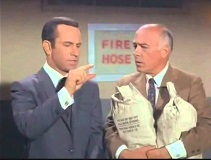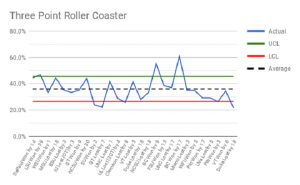 Knowing the Irish were in the NCAA Tournament until Davidson grabbed its spot by upsetting Rhode Island in the Atlantic 10 championship game is, as Mike Brey said, another gut punch in a season of gut punches. Being the #1 seed in the NIT is cold comfort, but the NIT it shall be. Notre Dame will face Hampton in Purcell Pavilion on Tuesday evening.
Knowing the Irish were in the NCAA Tournament until Davidson grabbed its spot by upsetting Rhode Island in the Atlantic 10 championship game is, as Mike Brey said, another gut punch in a season of gut punches. Being the #1 seed in the NIT is cold comfort, but the NIT it shall be. Notre Dame will face Hampton in Purcell Pavilion on Tuesday evening.
It’s easy to point at another team that made the NCAA field and make a case for its exclusion and ND’s inclusion especially given the injury losses Brey’s team had to overcome just to be considered. It’s a different team with Bonzie Colson in the lineup, 13-4 with its best player and 7-10 without him; and when second leading scorer Matt Farrell missed five games while Colson wasn’t available, the Irish were 1-4. On top of those losses, talented freshman DJ Harvey was lost for the season’s final 15 games (and counting) just as he worked his way into the starting lineup.
Missed Opportunities
It’s admirable that the team overcame so much uncontrollable adversity to be in consideration for the NCAA Tournament, but there were many missed opportunities along the way. Having Colson certainly would have made a difference in close losses to North Carolina, Louisville, Virginia Tech, and Miami, but the Irish were healthy for December losses to mediocre Ball State and Indiana squads. Those two games are the counterpoint to Brey’s “top 20 team when I have all of my guys” argument.
Still there were missed opportunities during the conference season, none more significant than the home loss to Miami on February 19th. The Irish had a chance to improve their conference record to 7-8 with Wake Forest and Pittsburgh to follow. They led the Hurricanes as late as the 7:00 mark of the second half only to lose by three points, 77-74.
“I thought we gave it away,” said an obviously angry Martin Geben after the game. “I thought we had a chance to win. It just came down to us needing to have heart, getting possessions, getting rebounds, getting some stops. I thought we gave it away.”
Understanding the significance of the loss, Matt Farrell was despondent.
“No excuses,” said Farrell. “We had guys on the floor who know how to play. This one hurts a lot.”
More than a lot, as it turned out.
The Shooting Roller Coaster
Notre Dame’s three point field goal percentage, 37.1%, ranks sixth in the ACC. That seems pretty good until one considers variance.
We all understand that there is an average because sometimes a team shoots a little better and sometimes it doesn’t shoot as well; but a coach hopes for consistent shooting. It’s hard to make a game plan for a team that is capable of making 55.2% and 60.9% of its threes in the two games against Boston College and 44.0% against North Carolina State but also made only 22.2% if its threes at Georgia Tech, 25.8% at Clemson, and 21.7% against Duke in the ACC Tournament.
Then there is the double overtime loss to Louisville, a 28.9% three point shooting performance. A performance to the team’s average in that game wouldn’t have gone to overtime.
 The chart to the right (click here for larger view) shows the team’s three point shooting percentage from game to game against major conference competition (plus Wichita State and Ball State) during the 2017-18 season. Until the end of the season, good shooting was a random event. Then it stopped being an event at all.
The chart to the right (click here for larger view) shows the team’s three point shooting percentage from game to game against major conference competition (plus Wichita State and Ball State) during the 2017-18 season. Until the end of the season, good shooting was a random event. Then it stopped being an event at all.
The Irish were 6-4 against major conference competition when they exceeded their three point average. They were 7-10 when their three point percentage was below their average. More importantly, Notre Dame shot worse than its average in 17 of the 27 significant games on its schedule. Consistent shooting was the key to winning with Colson out of the lineup, and that didn’t happen.
The Future
Robby Carmody and Dane Goodwin should change the shooting variance over the next several years. Both incoming guards, known as outstanding shooters, should alleviate the consistency issue on their own; but there is additional good news tied to their shooting prowess. TJ Gibbs was a 42.2% three point shooter with Farrell in the lineup with him, but he was only a 34% three point shooter when his shooting was the focal point of opposing defenses when Farrell was injured.
Add talented transfer big man Juwan Durham, Nate Laszewski’s inside-out presence, Prentiss Hubb’s penetration game, and Chris Doherty’s physicality and you have a group that will complement the veterans immediately before it develops into the foundation for an ACC contender on its own.
More immediately, the Irish will play in the NIT. They have the ability to win it, but the inconsistency I described above makes it hard to envision a five game winning streak against good competition. I’d like to be wrong.
Matthew Skinner says:
Despite the upper left usually being the “overall #1” seed (and maybe the NIT committee re-evaluated and made their own seedings, or maybe they don’t care to differentiate the four #1 seeds) but according to the committee the irish were NOT the first team out, but second:
https://www.cbssports.com/college-basketball/video/2018-ncaa-tournament-first-four-out/
Tom D says:
An underachieving team even with all players healthy. Beyond Bonzie and the improved Geben not much out there. Farrell shooting threes from 10 feet beyond the arc? Won’t win N.I.T., but no one cares even if you do. Need the football and basketball teams to stop settling for three star type players.
Mike Coffey says:
You might want to check out the incoming class